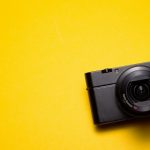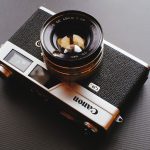The best part of mirrorless cameras with image stabilization is that it doesn’t tie you down to a particular lens. Regardless of the lens, you can still get the benefit of image stabilization. Plus, you get clear and crisp images even when the ISO is on the lower end. And hey, they are robust and lightweight, which is a bonus. As noted earlier, mirrorless cameras with image stabilization features are available across different price ranges and camera preferences. And in this post, we will compile a list of all the cameras with the said feature. Let’s get started, shall we? But first,
Here are the best fluid head tripods for still photos and videosTake a look at these 4K IPS monitors for photo editing
1. Panasonic Lumix GH5 II
Sensor size: 17.3 x 13 mm | Resolution: 5184 x 3888Image stabilization: 5-axis stabilizationSensor type: CMOS
The latter is especially important if you are a content creator and want to share a snippet of your work directly with your audience. The Lumix GH5 II establishes the connection through Wi-Fi and the connected app on your phone. This mirrorless camera is lauded for its support for Anamorphic image stabilization mode. At the same time, it supports a wide variety of formats, frame rates, resolutions, and bit rates. The GHS II offers a variety of movie-making options, which adds to its versatility. It is fast and is quick to record images. If we talk numbers, it can shoot full-resolution images at 12fps. Again, the battery life is decent, and on a single charge, you can expect to capture around 400 pictures. Cool, we’d say.
2. Canon EOS R5
Sensor size: 36 x 24mm | Resolution: 8192 x 5464Image stabilization: 5-axisSensor type: CMOS
The 45-megapixel sensor of the EOS R5 delivers clear and crisp images and has excellent color reproduction. At the same time, the RAW files capture enough details, which makes them good for post-processing. At the same time, the EOS R5 is one of the first Canon cameras to come with in-body image stabilization. So not only do you get shake-free and blur-free images, but the 8-stop stabilization also ensures that you can add other stabilization-free lenses to your kit without compromising in quality. The best part is that it has a light and compact body, making it easy to film and capture photos. Plus, the buttons and controls are similar to most Canon DSLR cameras. The battery can see you through around 4 hours of usage with the EVF (or Electronic View Finder) on. More importantly, the EOS R5 is built like a tank and can take its share of abuse. You can also shoot in any condition, be it biting-cold or a hot & humid climate.
3. Sony A1
Sensor size: 35.9 x 24 mm | Resolution: 8640 x 5760Image stabilization: 5-axis stabilizationSensor type: BSI-CMOS
It sports a bevy of features such as autofocus, EVFs, a compact model, and a fast processor like the one above. The Sony A1’s processor is comparable to the EOS R5. It can shoot 155 compressed RAW files before the buffer gets filled up. The main advantage of this camera is its EVF (or Electronic View Finder). The OLED of the EVF displays sharp and bright images. And the odds are that you will do well without the conventional viewfinder. The EOS R5 and Sony A1 are similar in terms of the build as well. The A1 also has a solid build and is weather-resistant, making it apt for any weather shooting. Last but not least, the battery of the Sony A1 is slated to last around 530 shots. And if you are shooting in 8K, you can expect more than an hour. It’s not without its issues. For one, the screen of the A1 only tilts up & down and doesn’t articulate. So while it’s great for capturing stills, it can be a bit challenging to capture videos.
4. Fujifilm GFX 100
Sensor size: 44 x 33 mm | Max resolution: 11648 x 8736Image stabilization: 5-axis image stabilizationSensor type: BSI-CMOS
Compared to the one above, the camera has a different look. Unlike the ones above, it has a tad different look and resembles Fuji’s Instax instant camera lineup to some extent. It weighs just 3.1 pounds, and the frame is fully protected against dust and splashes. The larger sensor means you get exceptionally good photos with greater details. This is because the RAW captures are noiseless and don’t have any visible grain. At the same time, the processor is fast and can hold up to 15 RAW images till the buffer fills up. The folks at PC Mag imply that the GFX 100 has one of the faster focuses among mirrorless full-frame models. Plus, the 5-axis stabilization means that you can crisp shot even when you capture photos without a tripod. Last but not least, the GFX 100 is powered by dual batteries. These batteries can see you through a day of moderate shooting. Huge, right?
Mirror Mirror on the Wall
These were some of the mirrorless cameras with image stabilization that you can buy. While these cameras let you capture great stills and videos both on the tripod or through hands, the effects of the image stabilization are not clearly visible on the viewfinder. At the same time, image stabilization is not as effective on long telephoto lenses. The above article may contain affiliate links which help support Guiding Tech. However, it does not affect our editorial integrity. The content remains unbiased and authentic.












